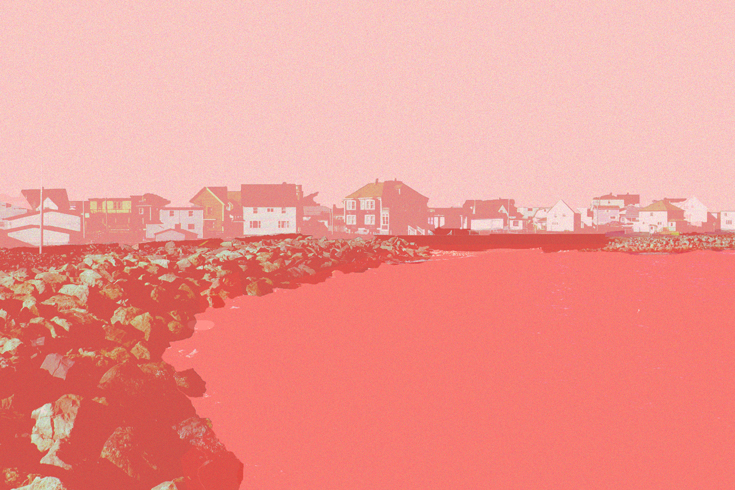Newfoundlanders have a curious, endearing, and no doubt maddening habit of giving directions by landmarks that no longer stand or have since changed into something else. Take a left where St. Pat’s school used to be, you might say, go past the old O’Brien house a good ways, and then turn right.
While this method of navigation may prove useless to anyone unfamiliar with the recent and sometimes distant past of the terrain, it’s worth considering what it says about the people who employ it. Situating oneself geographically in relation to things no longer extant can be a politically charged act of reclamation. The passage of time may have taken the last of the O’Brien clan some while ago, but it hasn’t taken the memory of their having existed, of their connection to that place. Such a historically sensitive lens is evidence of not only an awareness of lineage but also a commitment to maintaining continuity with the past, inviting it to inflect the present.
If you’re looking for a guide to the island portion of Canada’s tenth province, you could hardly do better than the poetry of Tom Dawe. Dawe’s disarmingly plain-spoken, quietly perceptive poems have been taught in Newfoundland high schools; he was named the poet laureate of St. John’s in 2010, a post he held until 2013; yet, on the mainland (a vague, sometimes playfully derisive term for anything west of Canada’s easternmost province), he remains relatively unknown. Chalk that up in part to his loyalty to local publishers, which possess a limited national profile. Whatever sense of him does exist in the rest of the country is, to borrow a phrase from Dawe, of a “folkish, past-oriented poet.” One might be forgiven for thinking him so: Dawe’s work is as much influenced by the oral storytelling tradition and folk beliefs of Newfoundland—with their frequent appearances of ghosts, fairies, and other imported old-country superstitions—as by canonical writers and poets and works of classical literature.
But to read Dawe as a provincial guide—the like of which one might find on a harbour boat tour perpetrating gaudy Screech-in ceremonies in the tourist-laden height of summer—would be a mistake. Dawe’s poetry, as evidenced by his recent New and Collected Poems, is as resistant to our current romanticized vision of Newfoundlanders as gregarious hosts (ever willing to lend a hand and possessing a booze-fuelled Celtic mirth manifested in rollicking songs at “kitchen parties”) as it is to the older notion of Newfoundland as a world of hardy fishermen and their stoic wives trying to scratch out a living from a harsh landscape. As he puts it in “Saltbox House”: it’s all “easy talk layered / like varnish. Somebody telling it / like it was.”
In “Peggy,” originally published in Dawe’s strongest collection, In Hardy Country, we are privy to the collective thinking of a community looking back after “everybody left the cove / for good.” The sense of displacement caused by the resettlement programmes of the 1950s, ’60s, and ’70s, which saw many communities relocated to larger, urban centres in order to reduce the cost of government services to the province’s small, geographically dispersed population and to diversify the economy from its traditional dependence on the fishery, had a destabilizing effect that still resonates in the Newfoundland psyche. In Dawe’s poem, the former inhabitants of this nameless community
[ . . . ] talk
of going back
to a cove of bliss
with bobbing skiffs
in blessed light
and quaint little houses
with good wives knitting.
There is no room in their sunny reminiscences for the less desirable aspects of living in an isolated locale, at the mercy of a single increasingly unreliable industry, often indebted by the “truck” system—a cashless economy in which merchants gave credit for fishing equipment and household supplies at the beginning of a season, dictating the price of fish only once the season was over so as to maximize profits. Instead, the passage of time and the physical distance have combined to gloss over the nuances of life in the cove the inhabitants left behind, buffing it to an impossible shine.
The man tending graves in “Caretaker” is another example of that buffing. As Martina Seifert points out in Rewriting Newfoundland Mythology: The Works of Tom Dawe, the caretaker is oblivious to the irony of his declaring “that the world has come / a long way / from the safe / and steady place / it used to be” while wandering among the markers of those dead of a firearm accident, infection, lightning, food poisoning, Spanish flu, and whooping cough. It’s hard not to read Dawe’s pragmatic approach here through the lens of Frost’s “time made simple by the loss / Of detail, burned, dissolved, and broken off.” Reverence for the past, Dawe warns us, can easily tip into nostalgia; and nostalgia, rather than challenging us to think critically about our experiences, can merely serve to reinforce our laziest thinking.
The best of Dawe’s poetry is about the difficulty of change, and more to the point, how we as individuals and societies reconcile our past and our present selves. With that in mind, we can read the sense of looming threat that sometimes appears in his work, “the death angel / perched in a dogberry tree / waiting” in “Visitation” or the “terrible water-bulls, / horned creatures / from the shadows / of Irish mythology, / looking up from the bottom / at frightened lobster fishermen” in “Circus,” as a proxy for the threat of change. In the latter poem, the specific threat is the encroaching force of American culture, piped in through early television screens: “Never again,” Dawe writes, “would the front room / be just for wakes and weddings.” Yet imported culture is not necessarily an imposition. In “Country Song,” the next poem in the Collected, the speaker’s uncle sings at a party, “quavering, faltering, off-key sometimes,” yet somehow engendering “an exorcism of sorts.” The adopted medium of country music, then, is not a threat to the island’s tradition of folk songs but a widening of possible forms of expression, of cultural repertoire.
This duality of vision—outside influence as simultaneous boon and bane—is evidence of Dawe’s refusal to reduce his Newfoundland to stark binaries but also a testament to a broader contradiction in the island’s culture: since the waters off the Grand Banks were first exploited for fish (in Newfoundland, read: cod; other species are referred to by common name), the settlers who stayed here have largely remained both dependent on and deeply suspicious of—if outwardly welcoming toward—outsiders. Thus, the title character of “The Bogey Man,” having begun life as the amorphous manifestation of a child’s fear of the dark and later in the poem morphed into a devilish character from folklore, finally settles into several visions of the Other: “a foreign sailor / spying on us from a fog / or an American from a base / coming to carry girls away”; “he might even be / a Canadian / or something,” Dawe jokingly concludes.
Bearing in mind that confederation for Newfoundland did not come until 1949—and even then with only a slim 52.3 percent majority vote in favour—it’s not hard to see how this province remains a bit ambivalent about the whole national project. Canadian identity has always sat uneasily on the shoulders of the youngest province even though that province has benefited from the union. Newfoundland has a long memory and keeps a running tally of tragedy. It bears the blame for the presumed extinction of the Beothuk with the death of Shanawdithit, in 1829. It still carries the mental scars of devastating losses suffered during the twin sealing disasters in 1914, the Battle of Beaumont-Hamel two years later, and the sinking of the Ocean Ranger offshore drilling rig in 1982. It has never gotten over the effects of resettlement or the imposition of the 1992 cod moratorium. Dawe was born in 1940; he would have been a child when, overnight, he became a Canadian.
The value of Dawe’s work lies in how it navigates such shifting identities not by ignoring or romanticizing the past but by looking on it with a tender and necessarily critical eye. His poems may be set firmly in Newfoundland, but they often marshal the timeless, placeless sense of folk tales and in this way achieve universal reach. “Once in a mind-over-matter spell”; “Back in that forever / of growing-up to touch the sky”; “When the plains were lush / in the lines of after-rain sun”: three separate Dawe poems begin bearing the incantatory rhythm of a fairy tale’s introductory formula. In the beautiful “At Western Arm”:
There was once a saw-mill here
giving a swift brook
its last fling
before it found the sea again.
There were houses too
with small front gardens
where lilacs shook
in fiord winds
and somebody turned earth
to plant an apple
or a rose tree
or some spot
of bleeding hearts.
But “now everything is gone / down / in a tangle / of alders / and the slow / revenge / of the birch,” the poem eventually ends. In that one word, revenge, Dawe exhibits a deep suspicion of our place in the natural world, or at least of our attempts to remake it. Apple and rose, bleeding hearts—all will be rewritten by the alders and the decidedly Frostian birch, which came before our imposition and will outlast it. Nature will inevitably reclaim everything we’ve taken on loan, and all our petty squabbles, “when great events were decided” (as Patrick Kavanagh puts it), will amount to nothing. Dawe’s gift is to take the sting out of this realization by reminding us that we are part of a greater whole. Just go past the place where the sawmill used to be and you’ll see exactly what I mean.





